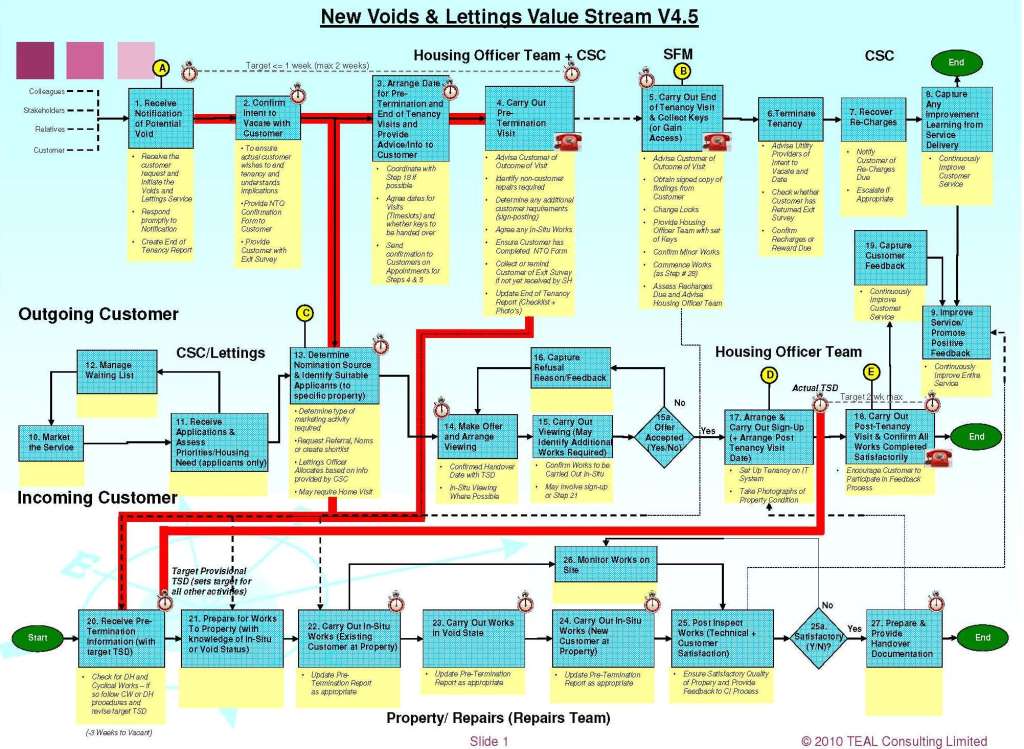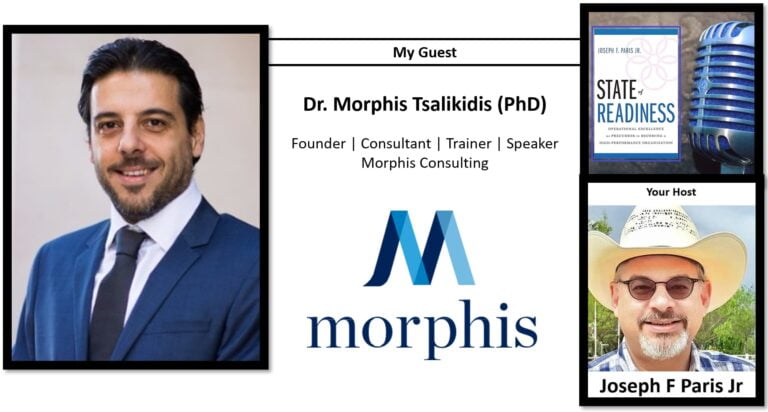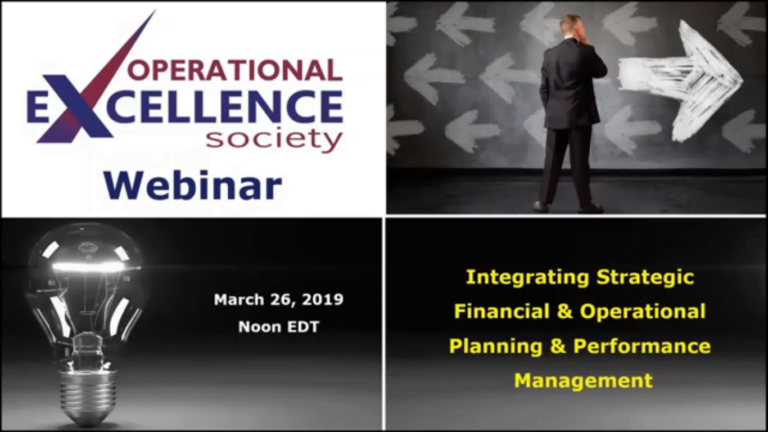Voids Lettings Case Study
A housing association working in the UK reported that a turnover of nearly £115m provides approximately 16,000 homes for more than 30,000 people. It works in partnership with local authorities, organizations and residents to create safe, sustainable communities. It provides:
- Rented family housing
- Homes for shared ownership
- Care and supported homes for older and vulnerable people
- Assisted living
- Hostel and student accommodation
The association wanted to improve its voids and re-letting service and engaged a consultancy firm to guide it through the first application of systems thinking based service transformation. In particular, it was interested in the impact that such an approach could have on its business and its customer satisfaction, as well as the time required to undertake the work (a 3 month target had been set) and how effective the approach would be in engaging with staff and current organizational culture.
At the heart of the change management program were the core principles of Focus, Excellenceand Efficiency. These principles closely aligned with systems thinking principles of:
- Focusing on what’s important to Customers (and to the organization and staff)
- Designing and delivering Excellent services which are consistently effective in meeting the needs of Customers
- Delivering what matters most with the minimum of resources, effort and waste
So although this was their first application of systems thinking it was well prepared for the challenges and new ways of thinking about would be required.
The consultants provided a proven lean systems thinking approach and experience to guide and support the housing association through its transformation of the Voids and Lettings service. The approach featured the following key stages:
Within Scoping & Preparation, the association’s project sponsor worked with consultants to clearly define the project scope and prepare the necessary project and resource plan. The sponsor also identified any constraints on the service itself or on the area/extent of changes which could be made during the project. The outcome of this preparation was that with the exception of regulatory requirements, the review team had pretty much a clean sheet to redesign an optimum service for customers. During this initial period, key information and data were identified which would be required during the project and would support the project sponsor in the engagement of staff who would form the in-house service review team. The team included customer Service Centre Staff, Lettings and Housing Officers and Facilities Management (FM); the in-house team providing void repairs services to the organization.
During the Diagnose and Understand stage the review team established a comprehensive understanding of how the service was currently designed and the current constraints and limitations which were impacting on the effectiveness and efficiency of service delivery. The review team involved customer focus groups to advise on what aspects of their voids and lettings service were really important and value adding for them and also the things which currently frustrated them and that they felt wasted their time.
After each main stage of the project, the review team would hold a Gate Review where the team would present their findings, conclusions and recommendations along with plans for the next stage. The sponsor and senior stakeholders would then give formal approval to proceed with the project and provide a commitment to provide any additional resources or input to the team which was required.
Following the first gate review the review team proceeded to the Re-design stage. In this stage the team used their clear understanding of customer and organizational requirements to design an optimised service delivery stream containing only steps which added value to the customer or served business critical requirements.
The service delivery stream highlighted a critical path (shown in red) which controlled the end to end void time which they were working to minimize. All other supporting activities needed to be completed in good time in order to not slow down work on this critical path.
The team then used this optimized delivery steam to re-design the supporting features of the service and to provide a complete definition of how things would work in practice which could be used in the Test & Refine stage. These features included.
- New more flexible roles for Customer Service, Housing and Lettings staff and more value adding roles for repairs and maintenance staff (particularly in assessing the repair work required and ensuring work was completed to the required standard in the shortest possible time)
- Streamlined, effective and efficient supporting processes linked to new clearer policies and procedures to ensure consistent, high quality service delivery
- Joined up IT Systems and Information Flows from Customer Service to Repair Contractors and Housing/Lettings Officers
- More joined up and meaningful measures of success and service KPI’s
The Test & Refine stage involves careful planning and preparation for how they would test out the new service design and who would be involved, including teams from different regions and customer service areas such as general needs and supported housing.
Once the majority of planning and preparation was complete, the review team ran an ‘Action Lab’ to check that staff was comfortable with how the new service would work and to allow it to address any obvious gaps or weakness in the design.
The Action Lab was based on bringing together the people, processes and technology used to deliver the new end-to-end service and then testing how the ‘complete’ system worked by processing realistic work examples based on real-life customer case studies. The facilitators were also able to add additional complexities into the work requests or remove necessary information from the service request to identify how the service would respond to these challenges.
Once the team had completed this one day Action Lab, it was ready to start a pilot phase taking and processing actual service requests from customers notifying the housing association of their intention to vacate the property. They then supported these customers, as well as new customers who were selected to view and consider new properties which were becoming available.
With the information provided by the Action Lab and the operation of the pilot over approximately 6 weeks, the review team was able to confirm that the new service design was working in the intended way and delivering the anticipated improved customer and business results.
The final stage in the project; Embed & Confirm involved carrying out detailed planning for implementing all the necessary changes required to sustain the new service design on a permanent basis. These included:
- Revising key policy and procedure documents
- Upgrading and providing improved information flows and reporting across key IT systems (CRM, housing and repairs contractor systems) – replacing a spreadsheet based tracking and reporting system which was developed to support the pilot
- Training and compliance processes to ensure staff are confident and consistent in their delivery of the new service
- Customer courtesy calls and 100% feedback on completed visits and work to drive continuous end-to-end service improvement
- A more joined-up way of managing and measuring end to end service success through a revised performance management framework and KPI’s
Looking back on the project the key features identified by the sponsor and senior stakeholders were:
- Front line staff were an active part of a project team leading a major service review (this was unusual for the organization and entirely what they wanted)
- The review made staff think about outcomes and the customer, rather than who does what
- The review has transformed the motivation and passion of some front line members
- The review has got front line staff in different departments and regions talking to each other and problem solving
- The review team identified that there were over 65 steps in letting one void but through their problem solving they reduced this to 27 steps
- The review identified that if the review team were to shave just 1 day off each void, they would save £14,000
- The process mapping provided a good template to look at business streams/areas across the organization
They are now completing the roll-out and embedding of the new voids and letting service design across the organization and other regions. Based on the service delivery evidence from the Test & Refine stage the projected benefits are:
- A £162,000 reduction in annual lost income for the one region alone
- Average void target 26 days, reduced from 37 days. Projected average through pilot – 21 with a further reduction to 15 days once all new design features embedded
- Improved customer satisfaction and the ability to tailor service delivery and timeframes to each customer’s circumstances
- Continuous improvement of all steps within the service delivery chain based on direct customer feedback
- Full ownership and commitment from frontline delivery staff to deliver the very best customer service in the most affordable way
 Eirian Lewis is a Director of TEAL Consulting who specializes in the delivery of improved business performance. He has over twenty years’ experience as facilitator, trainer, and change consultant and is a trained Lean Sigma Green Belt. TEAL’s focus includes applying solutions that are directed at business needs and designing programs that create sustainable change through improved individual, team and organizational effectiveness.
Eirian Lewis is a Director of TEAL Consulting who specializes in the delivery of improved business performance. He has over twenty years’ experience as facilitator, trainer, and change consultant and is a trained Lean Sigma Green Belt. TEAL’s focus includes applying solutions that are directed at business needs and designing programs that create sustainable change through improved individual, team and organizational effectiveness.
For more information about this project and the impact of a lean systems thinking approach please contact Eirian Lewis at eirian@tealconsulting.co.uk.










